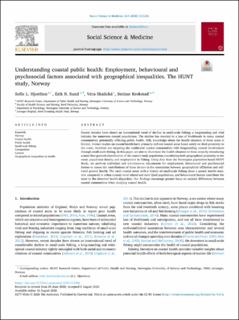| dc.contributor.author | Hjorthen, Sofie Lauvås | |
| dc.contributor.author | Sund, Erik | |
| dc.contributor.author | Skalicka, Vera | |
| dc.contributor.author | Krokstad, Steinar | |
| dc.date.accessioned | 2021-03-04T12:02:12Z | |
| dc.date.available | 2021-03-04T12:02:12Z | |
| dc.date.created | 2020-10-13T11:51:35Z | |
| dc.date.issued | 2020 | |
| dc.identifier.citation | Hjorthen, S. L., Sund, E. R., Skalicka, V. & Krokstad, S. (2020). Understanding coastal public health. Employment, behavioural and psychosocial factors associated with geographical inequalities. The HUNT Study, Norway. Social Science and Medicine, 264: 113286. doi: | en_US |
| dc.identifier.issn | 1873-5347 | |
| dc.identifier.uri | https://hdl.handle.net/11250/2731630 | |
| dc.description.abstract | Recent decades have shown an international trend of decline in small-scale fishing; a longstanding and vital industry for numerous coastal populations. The decline has resulted in a loss of livelihoods in many coastal communities, potentially afflicting public health. Still, knowledge about the health situation of these areas is limited. Former studies on coastal health have primarily defined coastal areas based solely on their proximity to the coast, therefore not targeting the traditional coastal communities with longstanding coastal involvement through small-scale fishing. In this paper, we aim to illuminate the health situation in these areas by introducing a more fine-grained classification of the coastal study population; considering both geographical proximity to the coast, population density and employment in fishing. Using data from the Norwegian population-based HUNT Study, we perform individual and simultaneous adjustments for employment, behavioural and psychosocial factors to assess the contributions of these factors to the association between geographical affiliation and self-rated general health. The rural coastal areas with a history of small-scale fishing show a poorer health situation compared to urban coastal, rural inland and rural fjord populations, and behavioural factors contribute the most to the observed health disparities. Our findings encourage greater focus on societal differences between coastal communities when studying coastal health. | en_US |
| dc.language.iso | eng | en_US |
| dc.publisher | Elsevier | en_US |
| dc.rights | Navngivelse 4.0 Internasjonal | * |
| dc.rights.uri | http://creativecommons.org/licenses/by/4.0/deed.no | * |
| dc.title | Understanding coastal public health : Employment, behavioural and psychosocial factors associated with geographical inequalities. The HUNT study, Norway | en_US |
| dc.type | Peer reviewed | en_US |
| dc.type | Journal article | en_US |
| dc.description.version | publishedVersion | en_US |
| dc.rights.holder | © 2020 The Author(s) | en_US |
| dc.subject.nsi | VDP::Medisinske Fag: 700::Helsefag: 800 | en_US |
| dc.source.pagenumber | 10 | en_US |
| dc.source.volume | 264 | en_US |
| dc.source.journal | Social Science and Medicine | en_US |
| dc.identifier.doi | 10.1016/j.socscimed.2020.113286 | |
| dc.identifier.cristin | 1839151 | |
| dc.description.localcode | Paid Open Access | en_US |
| dc.source.articlenumber | 113286 | en_US |

